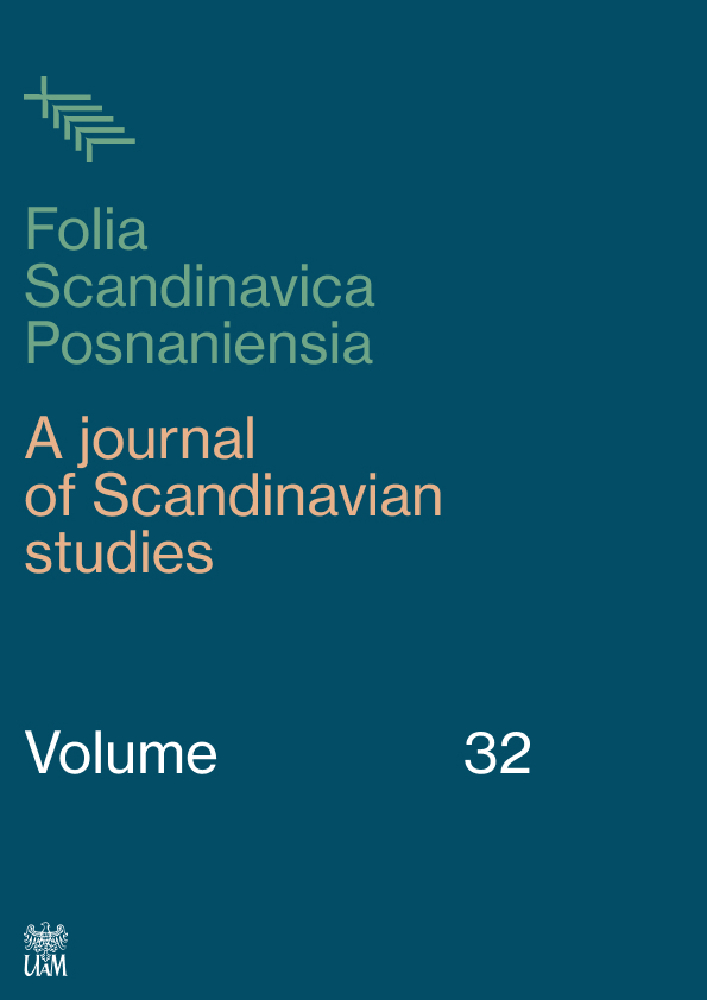Abstract
This article analyses the hitherto unexplored influence of Edvard Munch on Karen Blixen's work. Blixen was a great connoisseur of art and can therefore be assumed to have known Munch's work. In the short story “De standhaftige slaveejere” we find several parallels to the so-called “Munch's pictorial model”, i.e. a set of common features of his work (specifically his expressionist phase). Most striking is the similarity of the characters to those in Munch's painting Kvinden i tre stadier, which Blixen adopts both in terms of their appearance and their archetypal roles. She is particularly inspired by the colour connotations associated with the characters portrayed in the painting, and creates the figure of a beautiful and innocent girl in a white dress accompanied by an ascetic governess in black. Even the male character in Blixen's short story recalls Munch's archetype of the weak, melancholic man who is about to be destroyed by women. We also find a significant parallel in relation to the typical composition in Munch's paintings, where the individual figures are merged into one. Blixen makes use of this composition in the concrete description of the figures in her story; at the same time, on an abstract level, it is possible to interpret both figures as one multidimensional figure.
Funding
This work was supported by the European Regional Development Fund project “Creativity and Adaptability as Conditions of the Success of Europe in an Interrelated World” (reg. no.: CZ.02.1.01/0.0/0.0/16_019/0000734).
References
Alarcó, P. (2015). Edvard Munch: Archetypes. Madrid: Museo Thyssen-Bornemisza.
Blixen, K. (1910). Dagbog fra Paris. Retrieved from http://www5.kb.dk/da/nb/tema/litteratur/karen_blixen/dagbog.html (21.06.2022).
Blixen, K. (1942). Vintereventyr. København: Gyldendal.
Blixen, K. (1969). Til fire kultegninger. In: F. Lasson (ed.), Karen Blixens Tegninger (p. 19–29). København: Forening for Boghaandværk.
Blixen, K. (1978). De standhaftige slaveejere. In: K. Blixen, Vintereventyr (p. 54–77). København: Gyldendal.
Brundbjerg, E. (1995). Kvinden, kætteren, kunstneren Karen Blixen. Charlottenlund: KnowWare.
Brundbjerg, E. (1996). Inspirationens veje. Bogens Verden (2). Retrieved from http://www2.kb.dk/guests/natl/db/bv/bv-96/2-96/bru.htm (21.06.2022).
Brundbjerg, E. (2000). Samtaler med Karen Blixen. København: Gyldendal.
Buchhart, D. (2009). Edvard Munch og Danmark. Danmark: Ordrupgaard.
Czymmek, G. (1998). Landschaft als Kosmos der Seele: Malerei des nordischen Symbolismus bis Munch 1880–1910. Heidelberg: Braus.
Dinesen, T. (1974). Tanne. Min søster Karen Blixen. København: Gyldendal.
Engberg, Ch. (2000). Billedets ekko: om Karen Blixens fortællinger. København: Gyldendal.
Engberg, Ch. (2005). Karen Blixen – en moderne samler. In: I. Z. Sørensen, G. Skytte, Karen Blixen og billedet (p. 31–36). Firenze: Polistampa.
Engberg, Ch. (2019). Latter og lettere beruset. Odense: Syddansk universitetsforlag.
Engelbrecht, T., Lasson, F. (1996). Karen Blixen i Danmark – Breve 1931–1962. København: Gyldendal.
Genette, G. (1991). Introduction to the Paratext. New Literary History (22/2), 261–272. DOI: https://doi.org/10.2307/469037
Hansen, F. L. (1998). Babette og det aristokratiske univers. København: Reitzel.
Heffernan, J. A. W. (1991). Ekphrasis and Representation. New Literary History (22/2), 297–316. DOI: https://doi.org/10.2307/469040
Ingles, E. (2012). Munch. New York: Parkstone International.
Juhl, M. (1982). Kvindens rolle, mandens maske. Om ”De standhaftige Slaveejere”. Blixeniana (1982), 309–327.
Knausgård, K. O. (2017). Så mye lengsel på så liten flate: en bok om Edvard Munchs bilder. Oslo: Oktober.
Krieger, M. (1992). Ekphrasis: The Illusion of the Natural Sign. Baltimore: Johns Hopkins University Press. DOI: https://doi.org/10.1353/book.68495
Krohg, Ch. (1920). Kampen for tilvaerelsen: Tanker om kunst. Norske kunstnere. Fremmed kunst. Oplysninger. København: Gyldendalske Boghandel, Nordisk Forlag.
Langslet, L. R. (1994). Henrik Ibsen – Edvard Munch: to genier møtes = two geniuses meet. Oslo: Cappelen.
Lasson, F. (1969). Indledning. In: F. Lasson, Karen Blixens Tegninger (p. 11–17). København: Forening for Boghaandværk.
Lessing, G. E. (2016). Laokoon: oder Über die Grenzen der Malerei und Poesie. Norderstedt: BoD.
Mørstad, E. (2003). Edvard Munchs bruk av slagskygger. Kunst og kultur 86(2), 66–97. DOI: https://doi.org/10.18261/ISSN1504-3029-2003-02-01
Prideaux S. (2005). Edvard Munch: Behind the Scream. New Haven: Yale University Press.
Sarvig, O. (1980). Edvard Munch’s grafik. Lyngby: Hamlet.
Spitzer, L. (1962). The “Ode on a Grecian Urn”, or content vs. metagrammar. In: A. Hatcher, Essays on English and American Literature (p. 67–97). Princeton: Princeton University Press. DOI: https://doi.org/10.1515/9781400877393-007
Stahr, R. (2019a). At male med ord. Realisering af billedkunst i Karen Blixens fortællinger. Scandinavian Philology, 17(1), 146–159. DOI: https://doi.org/10.21638/11701/spbu21.2019.109
Stahr, R. (2019b). Høje kvinder og fede mænd. Karikatur som et stilistisk virkemiddel i Karen Blixens fortællinger. Acta Universitatis Carolinae Philologica, (3), 89–98. DOI: https://doi.org/10.14712/24646830.2019.33
Stahr, R. (2020). To eller tre englænderinder? Courbets maleri som idéimpuls for Blixens fortælling ”De standhaftige Slaveejere”. Acta Universitatis Carolinae Philologica. (1), 23–38. DOI: https://doi.org/10.14712/24646830.2020.18
Steinberg, S., Weiss, J. (1954). The art of Edvard Munch and its function in his mental life. Psychoanal (23), 409–423. DOI: https://doi.org/10.1080/21674086.1954.11925955
Sørensen, I. Ž., Togeby, O. (2001). Omvejene til Pisa. En fortolkning af Karen Blixens ”Vejene omkring Pisa”. København: Gyldendal.
Sørensen, I. Ž. (2005). Tizians Gudinder i Karen Blixens fortællinger. In: Ivan Z. Sørensen, G. Skytte (ed.), Karen Blixen og billedet (p. 17–24). Firenze: Polistampa.
Sørensen, I. Ž. (2021). Blixens humor. Sorø: U Press.
Wedell, L. (1986). Det besatte køn: kvindelighedsdannelser fra Reformationen til i dag. Århus: Aarhus Universitetsforlag.
Westenholz, A. (1985). Den glemte abe: Mand og kvinde hos Karen Blixen. København: Gyldendal.
Yacobi, T. (1995). Pictorial Models and Narrative Ekphrasis. Poetics Today (16), 599–649. DOI: https://doi.org/10.2307/1773367
License
Copyright (c) 2022 Radka Stahr

This work is licensed under a Creative Commons Attribution 4.0 International License.

